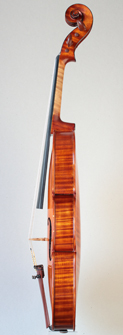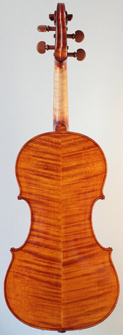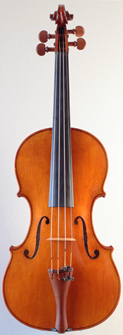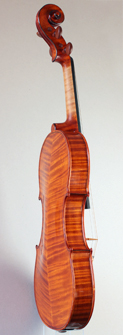Violin by Arthur Toman, Boston, MA, USA, 2002
|
|
|
| |||||||||||||||
Description — Dynamic
At some point Arthur Toman had in his shop both the "Plowden" and "d'Egville" twin
Guarneris of 1735.
Our violin's outline, soundholes, and wood type correspond closely to them.
So do the small size, flat arching, and deep ribs, which give the viewer a compact impression.
Black ink marks the bevels of the scroll, ribs, f-holes, and button.
The neck is thus elegantly framed by a chin and button which imitate each other,
the two-piece back's joint line following the head's central spine.
Toolmarks are clearly visible, even on the belly surface, showing the maker's sure technique.
Edgework flows naturally through simple and handsome purfling,
without affected bee-stings pointing inwards.
The brittle varnish has developed some craquelé along the vibrating paths.
Its warm orange color becomes deep brown inside the profound curls of the glorious maple.
I perceive a 10:10 o'clock upward motion from
the back's diagonal stripes,
the volutes' last half turns into the eyes of the scroll,
and the soundholes' wings —
upbeat, energetic lines.
Provenance — From the Maker's Estate
This is one of a few violins still in Arthur Toman's possession at the time of his
tragic death in 2004. His widow, Donna Toman, very kindly wrote to me,
"He was in vital condition when he made the one you have. It has never been owned by
anyone--he just kept it because he really liked it."
Seeing it for the first time, I assumed this violin would sound slightly small,
high-pitched and rough, owing to its small size (35.1 cm) and the fact it was new.
How I was surprised to hear a full-bodied, sweet, smooth, and large tone!
It does sound like
a modern violin, but one that has an already-established character.
And here I thought a new instrument needed time to sound good! ... Unless Art Toman
himself played it in (he was also a violinist) ...
in which case the charming sound we are hearing is his.
Tone — Bountiful
This violin sounds
lovely, warm, round, enthusiastic, very sonorous, both thick and refined, like honey. In
every part of the range, the tone keeps its clear, lustrous treble overtones over a mellow cushion of
hefty fundamental notes.
Interestingly, pushing it to play louder creates more
mass of sound, unlike other violins which seem rather to focus their existing sound.
How can acoustic matter be created on the spot? How can such a heavy sound come from such
a light object? Since meeting this Toman, I understand how a violin can be
nicknamed "the cannon."
This one's emission is immediately resounding despite its heavy load.
Its timbre brings to mind a pretty, young, healthy, sensual, lyric soprano —
buoyant with joy, not too intellectual, far from life's harsh realities and
existential burdens.
Playing this violin, for me, is an escape into the world of youth and possibilities.
Playability — Effortless
Arthur Toman conceived his violins with the player in mind.
Here everything is designed for ease of playing:
small size, short corners, perfectly proportioned neck and string length, light weight, angled bridge,
and quick tone production. The slightest bow movement is translated into sound.
You can rehearse all day without getting tired on this fiddle.
Also, it doesn't have a wolf tone, rather a wolf "zone" of
four or five semitones, thus scales and runs remain remarkably regular,
however the soundpost is adjusted.
It feels right at home from the start — hard to put down.
Strings — Tension Matters

The original bridge is quite tilted: short treble side and tall bass side.
I've decided to trust the maker and keep it on.
With a thin and flexible soundboard such as this Toman's,
one needs overall low tension strings not to stifle the violin. Moreover, with a tilted bridge,
one needs a heavy E and a light G string, to make up for the low tension on the short E side and
the high tension on the tall G side. The following sets have sounded good:
- 46.3 lbs.: Pirastro Tonica soft with medium E (G: 10.1, D: 9.3, A: 10.4, E: 16.5)
- 47.4 lbs.: Thomastik Vision soft with Lenzner Goldbrokat E
(G: 9.4, D: 9.4, A: 11.6, E: 17?) - 47.7 lbs.: Pirastro Violino (G: 9.5, D: 9.7, A: 11.5, E: 17.0)
- 47.8 lbs.: Larsen Virtuoso (G: 9.6, D: 9.6, A: 11.7, E: 16.9)
- 48.3 lbs.: Thomastik Dominant (G: 9.9, D: 9.1, A: 12.1, E: 17.2)
- 48.5 lbs.: Warchal Ametyst (G: 9.7, D: 9.3, A: 12.0, E: 17.5)
- 49.0 lbs.: Pirastro Oliv (stiff G and silver D) with Tonica wound E
(G: 9.3, D: 11.0, A: 11.5, E: 17.2) - 49.3 lbs.: Thomastik Vision Titanium Orchestra with Titanium Solo E
(G: 9.9, D: 9.9, A: 11.9, E: 17.6) - 49.3 lbs.: Pirastro Wondertone Solo (G: 9.7, D: 10,1, A: 12.3, E: 17.2).
 |
 |
 |
 |
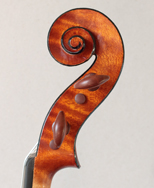 | ||||
| The narrow crown looks almost pinched (viewed from the front), however the eyes of the volutes unfold far to the sides, restoring the balance. | ||||||||
Bibliography
More about Arthur Toman:
- "Between the Notes - Making Art's Cello" by James N. McKean, Shire Press, 2012.
- "Art's Cello" on
FaceBook.com.

- "Arthur Toman, 57; fashioned elegant string instruments" on Boston.com by Tom Long, The Boston Globe, 16 June 2004.
- "Bench Marks: Passings: Arthur Toman", Strings, December 2004,
vol. 19, no. 5, issue 124, page 13.

- "News & Events: String Losses: Art Toman", The Strad, September 2004, vol. 115, no. 1373, page 881.
- Forum Discussion about Arthur Toman on Violinist.com.
- "The Violin Makers of the United States" by Thomas J. Wenberg, Mt. Hood Publishing Company, Oregon, 1986, pages 305-306.
- "Dictionnaire Universel des Luthiers" by René Vannes, volume 3 by Claude Lebet, Les Amis de la Musique, Brussels, 1985, page 71.
Measurements & Data
Maker: Arthur Robert Toman (1947-2004)
Made in: Boston, Massachusetts, USA
Year: 2002
Back Length: 351 mm *
Upper Bouts: 165 mm *
Middle Bouts: 109 mm *
Lower Bouts: 204 mm *
Stop Length: 194 mm
Rib Height at Neck: 30 mm *
Rib Height at Endpin: 31.5 mm *
Thickness of the Top: 3.0 mm
Thickness of the Back: 3.9 mm
F-hole Length: 77.8 mm *
Distance Between F-holes: 41.5 mm *
Distance Edge-Purfling: 3 mm
Scroll Width: 43.5 mm *
Weight: 411 grams
Label:
Arthur Toman of Boston
Made in 2002 (AT)
Inscription: To the inside back, "Arthur Toman of Boston
Made in 2002 ".
Brand: Branded "(AT)" on the upper block and on the label. Branded "Arthur Toman Boston" on the bridge.
Condition: New, immaculate (some varnish chipping). Original in all its parts, including bridge and soundpost.
* measured with a caliper
Maker: Arthur Robert Toman (1947-2004)
Made in: Boston, Massachusetts, USA
Year: 2002
Back Length: 351 mm *
Upper Bouts: 165 mm *
Middle Bouts: 109 mm *
Lower Bouts: 204 mm *
Stop Length: 194 mm
Rib Height at Neck: 30 mm *
Rib Height at Endpin: 31.5 mm *
Thickness of the Top: 3.0 mm
Thickness of the Back: 3.9 mm
F-hole Length: 77.8 mm *
Distance Between F-holes: 41.5 mm *
Distance Edge-Purfling: 3 mm
Scroll Width: 43.5 mm *
Weight: 411 grams
Label:
Arthur Toman of Boston
Made in 2002 (AT)
Inscription: To the inside back, "Arthur Toman of Boston
Made in 2002 ".
Brand: Branded "(AT)" on the upper block and on the label. Branded "Arthur Toman Boston" on the bridge.
Condition: New, immaculate (some varnish chipping). Original in all its parts, including bridge and soundpost.
* measured with a caliper


